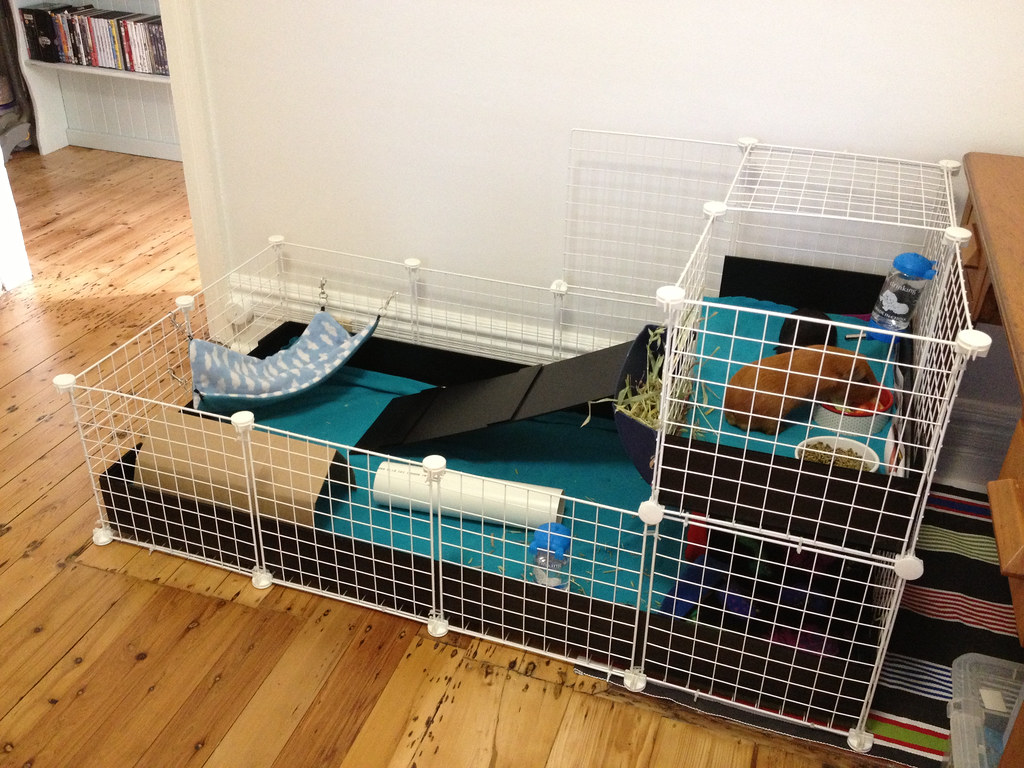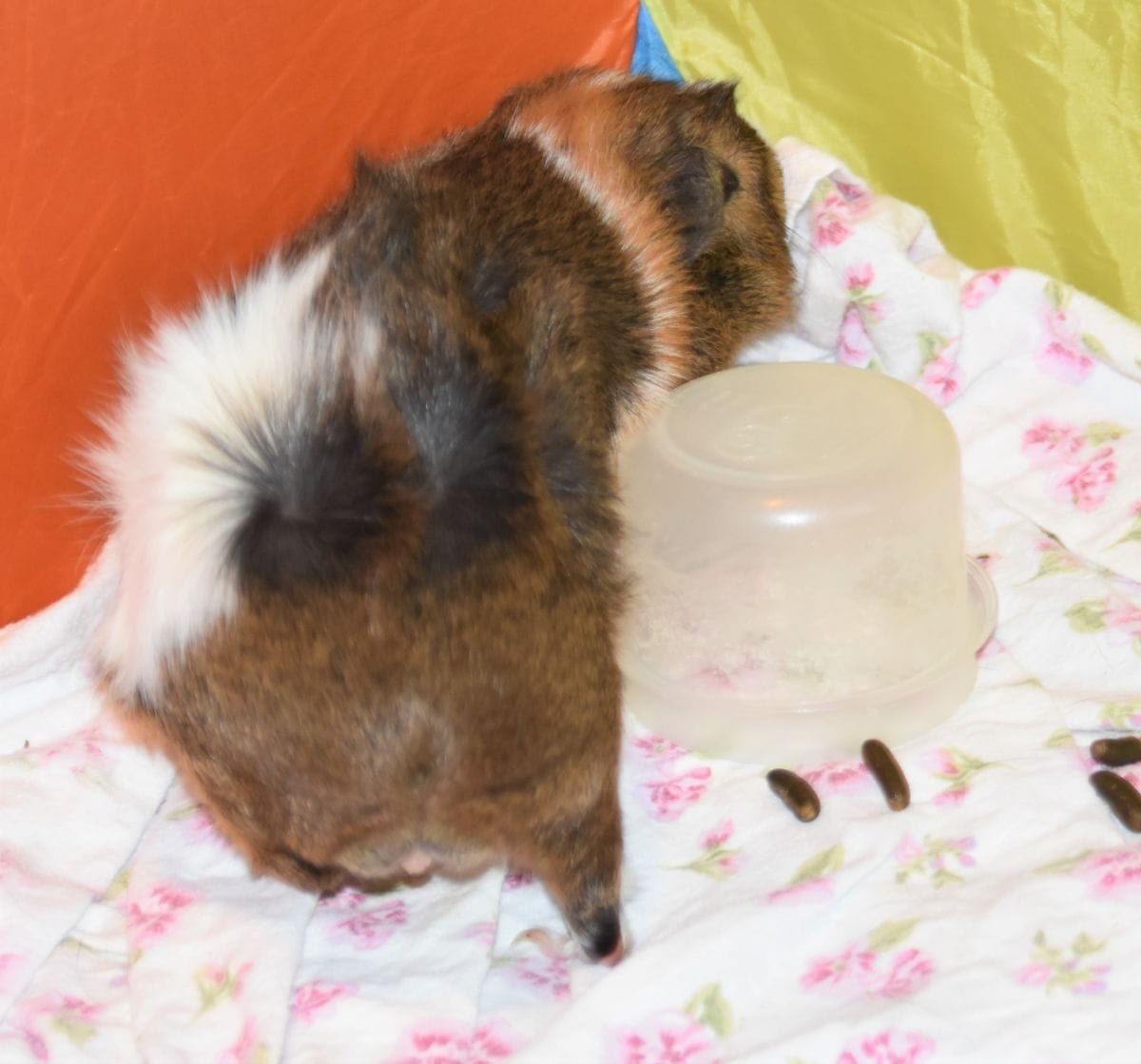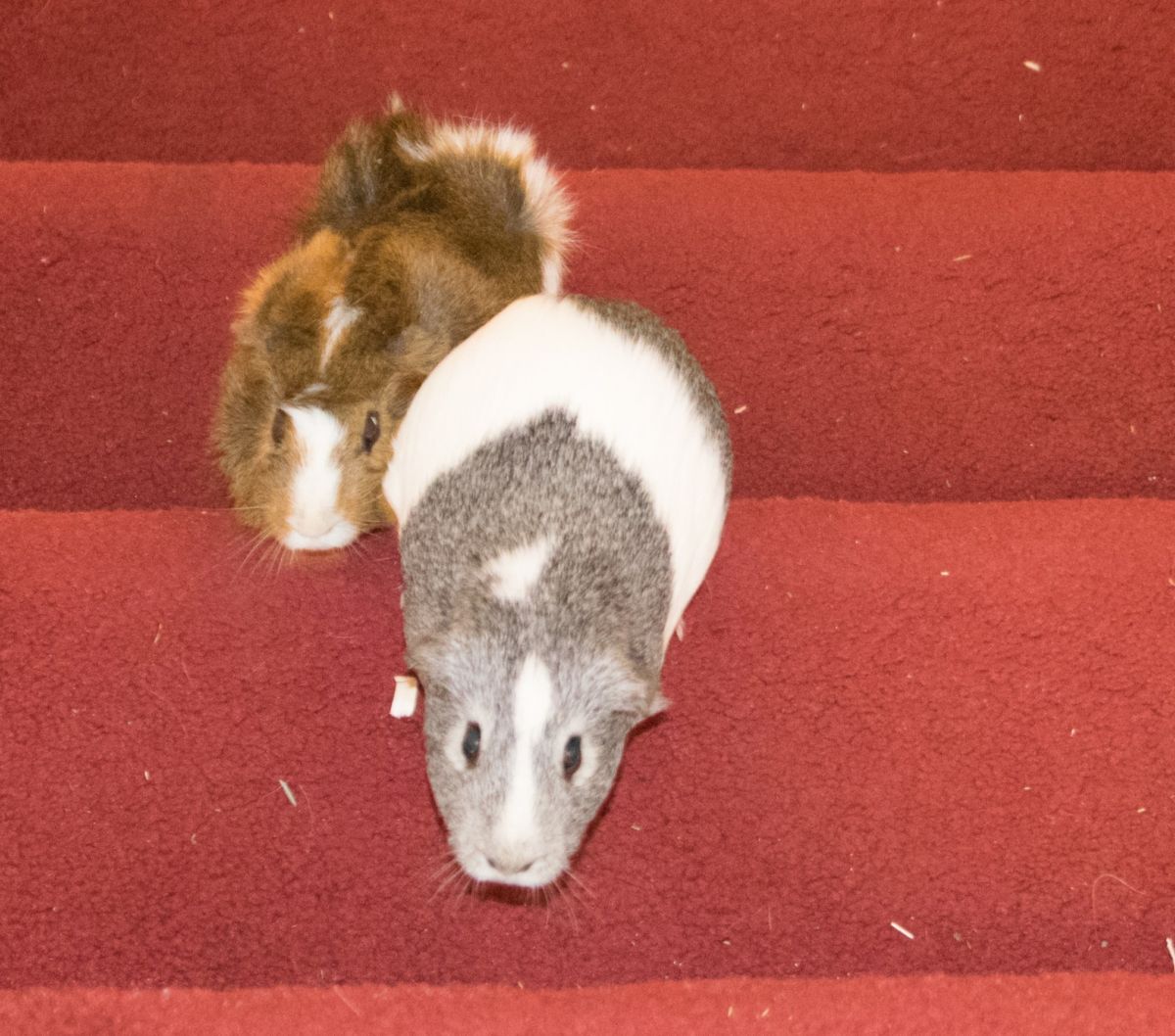Have you ever wanted to bring your guinea pigs outside to play (or live)? If so, were you unsure of how to do it safely?
Today, I will tell you about the following topics:
- Letting your piggies play outdoors
- Pros and cons of letting your guinea pigs live outdoors
- How to choose, set up and take care of your hutch
- Predator-proofing the habitat
- Other things to consider before housing your guinea pigs outside
- FAQs
- Caring for your outdoor guinea pigs
Let’s go!
Letting Your Piggies Play Outdoors
Whether or not you want your guinea pigs to live outdoors, they should definitely enjoy at least playing outside (and possibly munching on some grass) on a nice day.
But wait! Before you just let your piggies run around outdoors, you should make sure that the weather is suitable for them.
It shouldn’t be really humid or stormy, etc. The best temperature for guinea pigs is about 64 to 73 degrees Fahrenheit (approximately 18 to 23 degrees Celsius) although it is okay to let them outside if it is a bit warmer or cooler than this.
The area where the piggies will be playing should be out of direct sunlight, clean, dry, etc. Other pets shouldn’t be able to access the area, and it shouldn’t be polluted with car fumes (or really anything for that matter).
When you do let your piggies play outside, put them in a playpen, so can’t run away easily. Also, make sure to closely supervise your guinea pigs if they are playing outdoors.

In the playpen, make sure that you provide at least one hideout per guinea pig, so they can easily hide if they feel scared. Also, it’s a good idea to give them a water bottle or bowl if they will be out for 30 mins or more, especially if it is a hot day.
If you are going to let the guinea pigs out to graze on the fresh grass, consider the following:
Make sure that the grass is fresh, dry and clean, and doesn’t contain any lawn chemicals, etc, as these can harm your guinea pigs.
Do not feed your piggies grass clippings, since they can cause bloat, which is very harmful for a guinea pig’s digestive system.
Slowly introduce grass to your guinea pig’s diet if it has never eaten it before.
Ensure that your guinea pigs don’t have access to any poisonous plants. If you don’t know whether or not a plant is unsafe, just don’t feed it at all.
Letting Your Guinea Pigs Live Outdoors
Although it is safe to house your precious piggies outdoors, it may not be best for everyone. Below are some pros and cons of letting them live outside.
Pros
It is a more natural way for them to live. By housing your guinea pigs outside, you are providing them with a more natural lifestyle. They will get to experience the sights and sounds of the outdoors in the security of their hutch, which should make their life a bit more interesting.
It is quiet and more peaceful outdoors. You yourself have probably noticed that it is more peaceful and quiet outdoors, compared to the sometimes chaotic indoors. This is something your guinea pigs will definitely appreciate, as they often get spooked by loud noises!
Your house will be more quiet. As much as we love our piggies, they can be quite loud, as they wheek, purr, rumble-strut, etc, even at night. If your guinea pigs live outside, your home will be a bit more quiet.
Your house will be less messy. If you have ever owned guinea pigs indoors, well, let’s hope you aren’t a neat freak.
Hay, bedding, fur, etc, will get ALL OVER THE PLACE, sometimes even if you have vacuumed your house the day before. So, if you do not want this much mess in your house, consider housing your piggies outside.
Your guinea pigs will experience the fresh air and sunshine. If they will be living outdoors, they will breathe in the fresh air and be in the sunshine, which is very healthy for them.
Cons
The weather is harder to predict outdoors. When you keep your piggies indoors, the temperature and humidity can easily be controlled. However, outdoors is different.
Although in some places, the weather stays just about the same all year ’round, in other places it may be warm and sunny one day, and stormy the next. This is something you certainly need to consider (I will talk more about this later).
It is more expensive. Housing your piggies outdoors is more costly, as buying (or making) a good, secure hutch costs quite a bit and if the guinea pigs will be living outside when it is hot/cold it will cost more money to ensure the hutch is temperature controlled, etc.
You won’t spend as much time with them. When you live inside and your guinea pigs live outside, you won’t spend as much time interacting with them.
You will need to check on the piggies often. If your guinea pigs are living outdoors, like I said earlier, you won’t spend as much time with them, which makes it important to check on your piggies a few times throughout the day.
How to Choose, Set up and Take Care of Your Hutch
Choosing a Hutch
If your guinea pigs will be living outdoors, it is crucial that you take the time to choose the best hutch possible for them to live in.
When choosing or making an outdoor hutch, ensure that:
- It is very sturdy, and made from durable materials.
- It is pet-safe. It shouldn’t have any sharp edges or wire bottoms. It also should be made from non-toxic materials.
- It is weatherproof. It should be able to withstand the weather you normally experience in your area, as well as other harsh weather conditions.
- It has a strong, weatherproof roof, and secure, firm locks.
- It is predator-proof (more on this later).
- It fits the minimum space requirements for guinea pigs
- It provides easy access to your pets, so you can easily care for and play with them.
- You should be willing to clean it often.
Setting Up a Hutch
Alright, once you have your hutch, you need to set it up. To set up the habitat, you will need: A water source, a hay rack, a food bowl, several hideouts and some toys and chews.
I strongly recommend using a high-quality, leak-proof water bottle instead of a water bowl outdoors, as your piggies can often easily knock over the bowl, which, if not cleaned up quickly enough, can attract insects, mold, etc.
As far as a hay rack goes, get one that your piggies cannot get stuck in. Also, don’t get a hay rack that you hang outside of the hutch (unless the hay rack has a cover on it), as rain, debris, etc will fall into the hay rack.
The food bowl(s) you use for your piggies should be heavy, so that they can’t tip it over.
Make sure to have at least one hideout per guinea pig. Avoid plastic hideouts, as they will quickly overheat when it’s hot out. If you want to save a bit of money on accessories, use cardboard boxes as hideouts!
Also, provide your guinea pigs with plenty of toys and chews. There are lots of toys and chews available in pet stores or online, but if you want to save some money on them, try making your own.
Taking Care of a Hutch
Now, since a good-quality hutch can be quite expensive, you probably want it to last a while. Here are some great tips to do so:
- Coat the outside of the hutch with a wood preservative or high-quality varnish such as Cuprinol or Minwax polyurethane before you first use it. Reapply it once a year–preferably before the wintertime-for best results.
- Check the outside of the hutch regularly for cracks or holes in the wood and fill them in with a wood repair kit.
- Before you first use the hutch, put a small amount of WD-40 on the locks, hinges and stays. Reapply as needed.
- Keep the hutch in a protected area if there are harsh weather conditions.
- Thoroughly clean, wipe down and disinfect the inside of the hutch once a week.
- Spot-clean the hutch a few times a week.
For more info about taking good care of your outdoor hutch, click here.
Predator-Proofing the Habitat
It is very important to make sure that your guinea pigs’ hutch is predator-proof, since there are many more predators outdoors than indoors.
The best way to do this is by making sure the hutch is very strong and sturdy. A good rule of thumb is: If you can fit something the size of an egg though any gap in the hutch, it is not secure enough.
The hutch must also lock firmly and you should not be able to simply twist the locks open. You may even want to use a padlock to ensure the hutch locks very securely.
If your hutch does not have a bottom, keeping the hutch on a hard surface, such as wood, or attaching a bottom made from wire mesh and digging the mesh under the ground, (so the guinea pigs won’t hurt their feet on it) will make the hutch even more predator-proof.
Also, consider what kinds of predators live in your area, as it will differ based on where you live, and take protective measures to keep out these predators.
If you have bought a hutch, but it does not meet all of these standards, you may be able to modify it so that it does. Also, if you keep your hutch on a screened-in-porch (or something similar) it may not be necessary for the hutch to be as predator-proof on it own, since it will be protected by a shelter.
Other Things to Consider Before Housing Your Guinea Pigs Outside
You May Want to Have an Indoor Habitat On Hand
If it gets too hot, too cold, your guinea pig is sick, etc, you should bring your guinea pig inside, so it is a great idea to have an indoor habitat that you can use if need be. Even just a large playpen can work!
Here are some ideas for alternative indoor guinea pig cages: https://www.smallpetparade.com/5-awesome-cage-alternatives/
FAQs
Can you leave a guinea pig in a run/playpen overnight?
The simple answer is no. You guinea pigs must always be secured in its hutch during the night.
Can you put an indoor guinea pig outdoors?
Yes, you can. But do this when the weather is in the 64 to 73 degrees Fahrenheit (approximately 18 to 23 degrees Celsius) range, so there isn’t such a huge temperature change for the guinea pig.
Can you put a baby guinea pig outdoors?
You can bring a baby guinea pig outside for playtime when the weather is nice, once it weighs 14oz (about 400g). Remember that a baby guinea pig is more vulnerable to temperature change than an adult, so you should wait even longer than this before letting it live outside.
Caring for Your Outdoor Guinea Pigs
Outdoor guinea pigs need slightly different care than indoor guinea pigs. For one thing, the bedding in the hutch should be temperature controlled.
During the warm months, use bedding that won’t make your piggies too hot, such as wood shavings (aspen and hemp are the only safe types) or cage liners.
And during the colder months, use bedding that should keep your guinea pigs warm, such as paper bedding (although fleece liners are warm and soft, they won’t be as good when it’s really cold, because they will only keep your guinea pigs’ bellies warm).
In addition to this, consider the amount of bedding. If it is really warm out, use only a thin layer of bedding. If it is very cold, use several inches of bedding.
Also, like I said earlier, make sure to keep the piggies in a predator-proof hutch.
Make sure to spot-clean the cage a few times a week.
Also, feed your guinea pigs more veggies than normal during the winter months, as they will be using up more energy keeping warm.
Cover uneaten food with a plastic lid. Uncovered food can attract insects, so be sure to cover (or take away) any uneaten food.
How to Care for Them in the Summer
If it is 79 degrees Fahrenheit (about 26 degrees Celsius) or higher, your guinea pigs are more likely to develop heat stoke, so if you don’t want to bring your piggies inside, use these methods for keeping them cool.
- Keep the hutch in a shady area, out of direct sunlight.
- Do not put the hutch in a shed or similar building, as this will be even hotter, due to poor air circulation.
- Place several ice packs (make sure they are made of real ice; not just cold packs) wrapped in cloth in the hutch, so that your guinea pigs can lay down on them to keep cool.
- Use a fan or air conditioning set on a low setting, with the draft pointed away from your piggies, to help cool them down.
- Refresh the water regularly with cold water.
Remember, if it gets really hot outside, bring your piggies in.
Also, if your guinea pig shows signs of heat stroke, such as drooling, panting, lethargy, laying on their side, increased respiratory rate, etc; Immediately bring it inside to cool it down.
Place the guinea pig in a bath (the water should be no more than 2 inches deep) with lukewarm (not cold) water, and slowly pour some water over your guinea pig’s back to cool it down.
Give it some water in a syringe (slowly, and only about 0.25mL at a time so the piggy doesn’t inhale it).
Take your guinea pig to the vet as soon as possible for treatment.
How to Care for Them in the Winter
If the temperature drops below 59 degrees Fahrenheit (15 degrees Celsius), your piggies are more likely to get chilled, so if you don’t want to bring them inside, use these methods for keeping them warm:
- Insulate (using a hutch cover) and keep the hutch out of the path of high winds.
- Keep the hutch in a shed or outbuilding (don’t keep them in a garage).
- Fill a cat carrier with hay for the piggies to snuggle in.
- Use warm water in the water bottle.
- Buy pet heating pads for the guinea pigs to snuggle with.
- Clean up wet areas in the cage quickly.
- If your hutch doesn’t have a floor, don’t put it on grass or concrete.
However, if it does get really cold out, or your piggies are sick, bring them inside.
I hope this has been very helpful!




